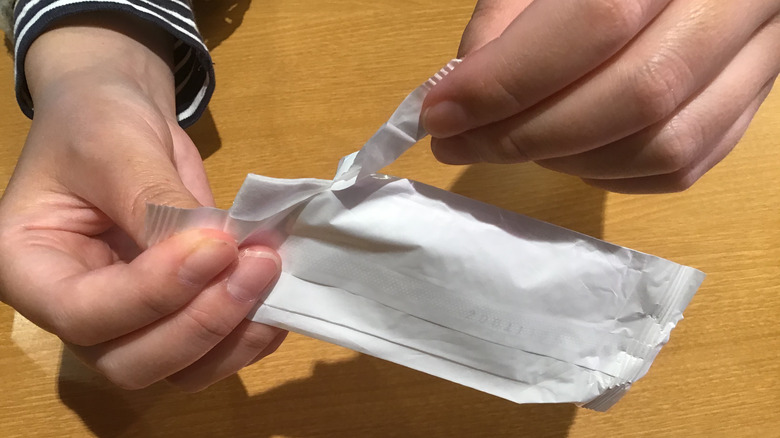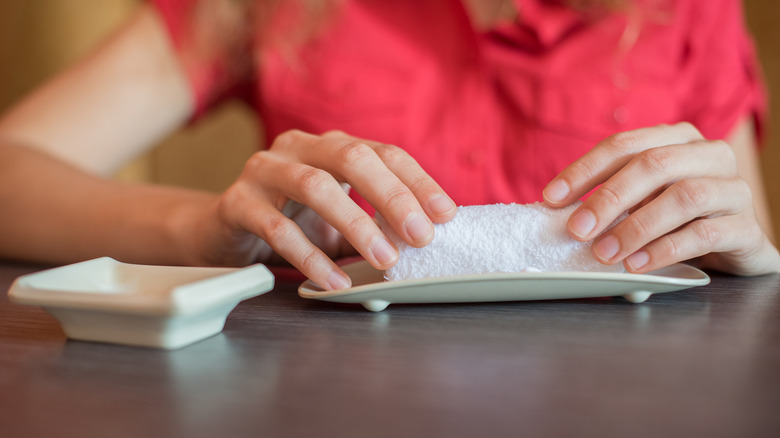The Wet Towel Rule Tourists Need To Know Before Visiting A Restaurant In Japan
You sit down at a restaurant in Japan, and along with being handed a menu, you're also given ... a wet towel? Nope, your server didn't mistake you for the dishwasher or restroom attendant. That wet towel is called an oshibori, and there's an important rule to know when using it.
Oshibori are given to diners so they can wipe their hands before starting their meal. The wet towel removes any dirt or residue so you can enjoy your food with clean hands. However, it's not meant for use on the face or any other body part. You might occasionally spot a local wiping their face with an oshibori, but this behavior is typically frowned upon in Japan. Just imagine: all the sweat, dirt, and oil on your face ending up on a towel, placed on the table next to your food. Even if that doesn't gross you out, it might make your fellow diners a little uncomfortable. If you feel tempted to wipe your face or any other body part, go to the bathroom to dab your skin with a piece of tissue. Or do as many Japanese do, and keep a hand towel or handkerchief in your bag (we recommend this TikTok-famous travel backpack) and use it as needed throughout the day.
Look out for the different types of oshibori in Japan
Whether you're ordering a traditional raw egg dish in Japan or a bento lunch from the local convenience store, you'll likely be given a rolled oshibori before you begin eating. However, oshibori don't all look the same. The more you travel around Japan, the more familiar you'll become with the different types of Japanese wet towels.
The first thing you may notice is that some oshibori are disposable and wrapped in plastic, while others are fabric towels that can be washed and reused. Some are a combination of both, where a reusable towel is wrapped in plastic designed to keep it moist and clean. Note that disposable oshibori aren't like the wet wipes you might have back home, even if they look similar. Unlike the sanitizing wipes you may be familiar with, oshibori are typically only covered in a preservative that inhibits the growth of mold and bacteria. In other words, they're safe to use but probably won't eliminate the germs on your hands.
You might also find oshibori that are hot or cold, depending on the season. A steamy oshibori is the norm in the winter months, while a cold oshibori is more likely to be provided in the summer. Some restaurants even have a special towel warming machine or refrigerator to maintain the ideal temperature of the clean oshibori.
Not wiping your face isn't the only oshibori etiquette to know
To be an especially considerate tourist when visiting Japan, be mindful of what you do with your oshibori after wiping your hands. Besides not wiping other parts of your body, it's good manners to fold the wet towel, keeping the dirty side (used for your hands) on the inside so it doesn't come in contact with the table. If your hands get dirty during or after your meal, it's generally considered okay to use the oshibori again to remove any residue.
If you need to wipe your mouth while eating, or if you spill your food or drink, look for another napkin. Most restaurants will provide additional paper napkins or, if you're at a fine-dining establishment, a cloth napkin. These are ideal for dabbing sauce off your mouth or wiping up food that dropped on the table.
Once you've finished your meal, make sure your oshibori is neatly folded and left on the table or in the oshibori tray, if provided. If you're eating a to-go bento or street food and were given a disposable towel, throw it away along with any other waste once you're done using it. If you have trouble finding trash cans in Japan, keep the oshibori towel and wrapper with you until you reach your hotel or accommodation, where you can dispose of it properly.


